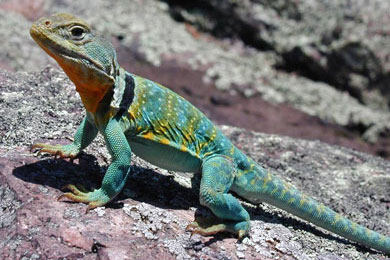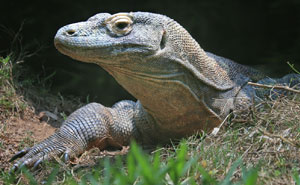Lizards
What are lizards?

Most lizards are small, with four legs and a long tail that in many species is fragile and easily broken but will regenerate; the tail of such arboreal species as the chameleon is adapted for grasping branches. They have dry scaly skin, and most have clawed feet and external ear openings.
They are distinguished from snakes by their movable eyelids and by differences in the structure of the skull bones, especially those of the lower jaw. The bones of the two halves of a lizard's jaw are firmly united whereas those of a snake are separable.
Lizards move in a variety of ways, depending on body structure and habitat. The collared lizard and the basilisk run quickly on well-developed hind legs, and the latter can also run across the surface of water using its greatly developed back legs and whiplike tail. The gecko has suction disks on its toes that enable it to cling to smooth surfaces. Some lizards are good swimmers, and a number are adapted for climbing trees.
Defence mechanism

Lizards have a wide range of defence mechanisms. Only two lizards are venomous - the beaded lizard and the Gila monster - and use their venom for defence. Many species of large lizards, although not venomous, can defend themselves against attack by biting vigorously.
When cornered, the horned lizard can spray an intruder with blood from the corners of its eyes or, like the chuckwalla, may retreat to a crevice and inflate its lungs with air, increasing its size so much that it cannot be pulled out of the narrow space.
The alligator lizard has protective, armour-like scales, while the agile swift darts behind the rocks or among the fallen trees of its habitat.
Many lizards are cryptically coloured allowing them to camouflage around their surrounding environment. Some lizards, such as the chameleon, can change their colours as the external environment changes.
What do they eat?

The diets of lizards vary greatly, depending on species. While most are insectivorous, some, such as the iguana, are generally vegetarians. The Gila monster, which lives in desert areas, eats reptile and bird eggs as well as small rodents.
Depending on their size, a monitor lizard can prey on insects, birds and reptiles and their eggs, small mammals, and carrion. One species, the Komodo dragon, is large enough to be a threat to humans.
Where can they be found?

Lizards are found in tropical and subtropical regions throughout the world. Few species are found in temperate regions and none in arctic areas.
Some are burrowing or terrestrial animals; some, arboreal, and others, semiaquatic. Iguanas are found in all three types of habitats.